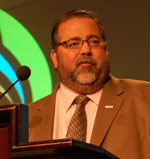 Growth Energy CEO Tom Buis says the decision by EPA today to allow up to 15% ethanol blends in 2001 and newer vehicles “knocks a bigger hole” in the blend wall, but they’re not going to give up until they completely “tear down that blend wall.”
Growth Energy CEO Tom Buis says the decision by EPA today to allow up to 15% ethanol blends in 2001 and newer vehicles “knocks a bigger hole” in the blend wall, but they’re not going to give up until they completely “tear down that blend wall.”
Buis held a telephone press conference today immediately after the announcement was made, along with Growth Energy co-chairman Wesley Clark, Todd Becker of Green Plains Renewable Energy (GPRE), Kent Satrang of Petro Serve USA and Rob Sjkonsberg of POET.
Clark expressed his appreciation to the administration for the decision. “I think they made a very wise decision in moving to bring this extra fleet of cars in,” said Clark. “It’s a huge step forward for national security.”
Addressing concerns about increasing amounts of corn used to make ethanol, Todd Becker with the Nebraska-based GPRE says the industry is getting more ethanol per bushel of corn. “A small improvement in yield in 2011, we believe, will add an additional 100-150 million bushels of corn to the carry-out, more than is expected today.”
Fuel retailer Satrang says they are ready to start using E15 as soon as possible. “This is great and significant news for America’s gas stations,” he said. “We intend to put E15 in 8 of our 20 store chains as soon as the required labels are available.” He says those are stores that have blender pumps already.
Listen to the Growth Energy press conference here. Growth Energy on New E15 Decision


 “EPA’s decision today is a sound one, but it doesn’t address the issues that still remain regarding a segmented market place and the introduction of a new fuel,” said RFA President Bob Dinneen. “The RFA will continue to work with EPA and other regulatory bodies to expand ethanol use beyond even 15%. Simultaneously, we will continue our dialogue with lawmakers to develop and implement sound, tax-based policies that provide the proper incentives to grow ethanol use across a variety of blending levels.”
“EPA’s decision today is a sound one, but it doesn’t address the issues that still remain regarding a segmented market place and the introduction of a new fuel,” said RFA President Bob Dinneen. “The RFA will continue to work with EPA and other regulatory bodies to expand ethanol use beyond even 15%. Simultaneously, we will continue our dialogue with lawmakers to develop and implement sound, tax-based policies that provide the proper incentives to grow ethanol use across a variety of blending levels.”  “Today’s decision greenlights the use of E15 for nearly two out of every three cars on the road today and furthers proves ethanol is a safe, effective fuel choice for American drivers,” said Renewable Fuels Association President Bob Dinneen. “EPA continues to move in the right direction with respect to increasing ethanol blends, but challenges still remain. The RFA continues to urge EPA to extend the waiver for E15 use to all cars and pickups.”
“Today’s decision greenlights the use of E15 for nearly two out of every three cars on the road today and furthers proves ethanol is a safe, effective fuel choice for American drivers,” said Renewable Fuels Association President Bob Dinneen. “EPA continues to move in the right direction with respect to increasing ethanol blends, but challenges still remain. The RFA continues to urge EPA to extend the waiver for E15 use to all cars and pickups.”  Brian Jennings, Executive Vice President of the American Coalition for Ethanol (ACE), says the move is another important step in making more renewable fuel choices available to consumers. “ACE continues to be confident that the scientific evidence proves E15 is safe and reliable for all cars, and is disappointed that EPA continues to insist of this confusing model-year division, especially when models earlier than 2000 are being excluded without scientific evidence of any issues with using E15 in those vehicles,” said Jennings. “We are pleased with this positive step, but remain concerned about the unnecessary confusion that will unfortunately be caused by EPA’s piecemeal, partial-waiver approach.”
Brian Jennings, Executive Vice President of the American Coalition for Ethanol (ACE), says the move is another important step in making more renewable fuel choices available to consumers. “ACE continues to be confident that the scientific evidence proves E15 is safe and reliable for all cars, and is disappointed that EPA continues to insist of this confusing model-year division, especially when models earlier than 2000 are being excluded without scientific evidence of any issues with using E15 in those vehicles,” said Jennings. “We are pleased with this positive step, but remain concerned about the unnecessary confusion that will unfortunately be caused by EPA’s piecemeal, partial-waiver approach.” The U.S. Environmental Protection Agency (EPA) today waived a limitation on selling gasoline that contains more than 10 percent ethanol for model year (MY) 2001 through 2006 passenger vehicles, including cars, SUVs, and light pickup trucks. The waiver applies to fuel that contains up to 15 percent ethanol – known as E15. EPA Administrator Lisa P. Jackson made the decision after a review of the Department of Energy’s thorough testing and other available data on E15’s effect on emissions from MY 2001 through 2006 cars and light trucks.
The U.S. Environmental Protection Agency (EPA) today waived a limitation on selling gasoline that contains more than 10 percent ethanol for model year (MY) 2001 through 2006 passenger vehicles, including cars, SUVs, and light pickup trucks. The waiver applies to fuel that contains up to 15 percent ethanol – known as E15. EPA Administrator Lisa P. Jackson made the decision after a review of the Department of Energy’s thorough testing and other available data on E15’s effect on emissions from MY 2001 through 2006 cars and light trucks. A delegation of representing Michigan ethanol producers hit Capitol Hill on Thursday for a series of meetings with members of Congress and their staff. The fly-in, organized by
A delegation of representing Michigan ethanol producers hit Capitol Hill on Thursday for a series of meetings with members of Congress and their staff. The fly-in, organized by 


 In addition to
In addition to  In rural western Alabama, Coskata, Inc. has received a letter of intent for a $250 million loan guarantee to construct and operate a cellulosic ethanol biorefinery facility. This 55-million gallon-per-year renewable biofuel project will use woody biomass to produce ethanol.
In rural western Alabama, Coskata, Inc. has received a letter of intent for a $250 million loan guarantee to construct and operate a cellulosic ethanol biorefinery facility. This 55-million gallon-per-year renewable biofuel project will use woody biomass to produce ethanol.